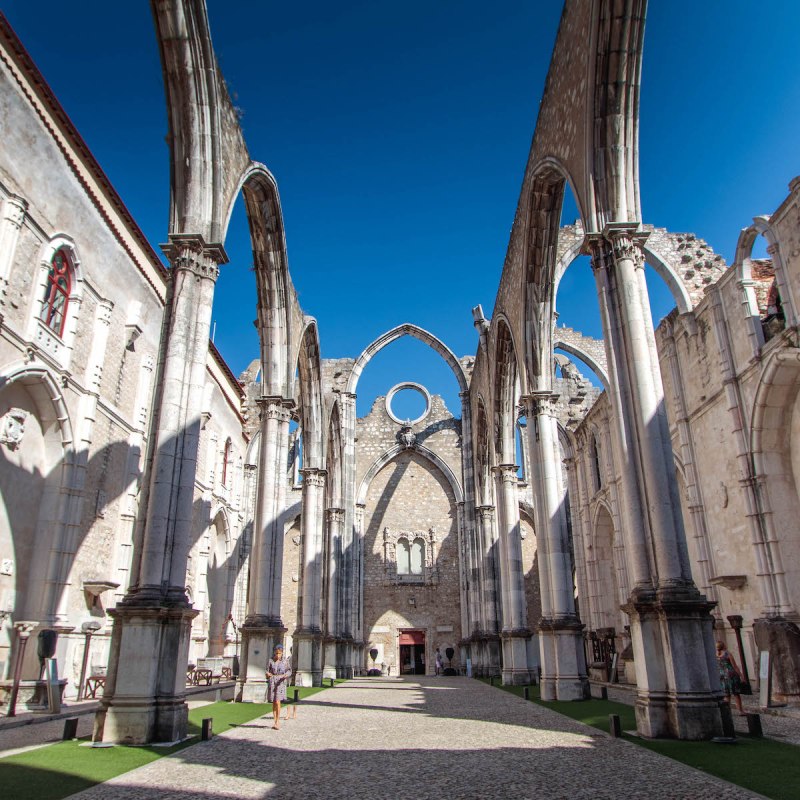
We were sitting under a large umbrella facing the square, sipping coffee, and people watching. It was mid-October, mid-70s, and we had just arrived in Lisbon and had already slipped effortlessly into the dolce vita. We were spending a long weekend in Lisbon and we were already in danger of sinking into a food and drink-induced torpor.
Videos by TravelAwaits
Heading to Lisbon? Check out our list of hotels in Lisbon that will make for a great home away from home.

Day 1 (Friday): It’s Hilly
With immigration formalities completed in our Munich transit stop, we breezed out of Lisbon airport, jumped into the back seat of a small taxi, and headed to our hotel just off Lisbon’s own Champs Elysée-like Avenida da Liberdade.
A quick change and we strode out to explore this historic capital. Cars sped down the Avenida da Liberdade but the wide, shady, tree-lined boulevards on either side had a very calming effect and our pace soon dropped to a sedate stroll between the trees. It wasn’t long before we had stopped altogether — enjoying a beer at an open-air table and soaking up the sun as if we were in the middle of a park.
We headed down towards Baixa (the downtown historical center) and the Praca do Comercio — a large square where the royal palace once stood. We were to learn that in 1755, the city was hit by the strongest earthquake ever recorded in Europe (8.5 on the Richter scale) causing a tsunami resulting in significant loss of life and destroying much of the city. The streets were subsequently laid out on a grid system and cobbled with small, black, and white limestone tiles. Lisbon is surrounded by hills and every route away from the waterfront takes you uphill. We trekked up many steep, cobblestoned streets, past imposing churches and building facades adorned with tasteful colorful tiles. In a narrow street, we dodged the famous “Tram 28” clanking around a corner and realized there has to be a better way to scale the hills. There is.

Day 2 (Saturday): Find The Elevators
We had arranged a half-day private tour of the city with a local guide. We slipped into our walking shoes and prepared to behave like a couple of Sherpas. We need not have worried. Our local guide not only regaled us with fascinating stories of Lisbon’s history but importantly, took us to all the sights without having to slog up and down hills all day long.
We started at the large Praca do Comercio — early. It was mostly deserted very early in the morning except for photographers busily snapping fashion models draped around the central bronze statue of King Jose I or playing peek-a-boo amongst the colonnades of the surrounding government offices, vendors, and restaurants. Everything we saw standing in Baixa was built after the 1755 earthquake. The rebuilding of the downtown area was done incredibly quickly, partly because the building design used only a few models that were replicated many times over — something you see once it’s pointed out to you and you say, “oh yeah.”
Pro Tip: Get a local guide to save you a bunch of effort.

We didn’t walk far before stopping for a pastel de nata — a traditional Portuguese egg custard tart sprinkled with cinnamon — at Manteigaria. Some say this is the best place to get these tarts and I would not argue. They come off the manual production line warm and melt in your mouth. Apparently, over 300 years ago, local nuns used egg whites to starch their habits, leaving egg yolks for other purposes. Mixed with flour, milk, and sugar, pastel de nata was born and today thousands are consumed daily.
Next up (literally) was a visit to Chiado — a fashionable shopping district with boutique stores, cafes, and restaurants. Our guide led us through a metro station and, using their escalators, we arrived with a spring in our step. We nodded smugly to other tourists who had trudged up the hill. We enjoyed a coffee in Brasileiro — a 1905 art deco café where the intellectuals used to hang out and browse around Bertrand bookshop which had survived another Lisbon disaster. In 1988, a raging fire in the Chiado district stopped less than 100 feet from the store. Today, a certificate from Guinness Book of World Records proclaims it to be the world’s longest continuously operating bookshop, having been established in 1732.
A short walk brought us to the Largo do Carmo — a charming, picturesque, shady square with the remains of the spectacular gothic Convento do Carmo monastery and, less spectacular but vitally important, headquarters of the Lisbon military police. It was here, on April 25, 1974, that people gathered to overthrow the authoritarian government in a bloodless coup, and democratic, modern-day Portugal was born. The square is also easily accessed by the 100-foot Santa Justa elevator from Baixa where visitors are afforded great vistas of the city. The ruins of the medieval 14th-century convent and church are now part of an architectural museum and well worth a visit.
No visit to Lisbon would be complete without a shot of the traditional Portuguese cherry brandy Ginjinha. There are street vendors where you can taste the liqueur but we were advised to only get the “real stuff” from a couple of hole-in-the-wall outlets off Rossio plaza. A Ginjinha is a tiny bar squeezed between shops. We tried it. It was good — we brought some home.

Suitably fortified, we headed a few paces to the Baroque church of Sao Domingo. Built in the 13th century and the site of both royal weddings and executions, this storied church has seen its fair share of disasters. Damaged by an earthquake in 1531 and again in 1755, it was gutted by fire in 1959. Today, worshippers pray surrounded by fire-damaged concrete walls and columns. It makes for a stark contrast to the many ornate gold leaf adorned churches elsewhere in the city.
We headed up to the oldest district in Lisbon — Alfama — using the elevator Castelo then another elevator beside an innocuous supermarket. We had breath to spare and our guide had just earned his tip. We took in great views of the red-roofed tiles and the Tagus River from one of many miradouros (skywalks). We orientated through a labyrinth of narrow, cobblestoned passages which could have been set in Marrakech. As we emerged into the Largo do Chafariz de Dentro, large tour groups had just been disgorged from an arriving cruise ship. Like sand in an hourglass, they were about to squeeze through the Alfama passages. Timing is everything — and we drank to that.

Day 3 (Sunday): UNESCO Site Beckons
Today we joined a small group tour —eight people — and headed west to Sintra, Cascais, and mainland Europe’s westernmost point, Cabo da Roca.
Sintra, about a 30-minute minibus ride from Lisbon, became the vacation getaway for the Portuguese royals from the 15th century and the brightly pastel-colored, fairytale-like Pena Palace was the highlight. Built by Ferdinand II in the 1800s, the palace is a mishmash of design styles, has been designated a UNESCO world heritage site, and is one of Portugal’s own Seven Wonders.
A short drive led us to delightful Sintra town. Dominated by the Grand White Palace in the town square, the real gems are to be found in the steep narrow streets leading up from the square. There are many places to sit outside to drink and eat yet the place must be shoulder to shoulder in the summer season. We were recommended to try two famous local pastries — travesseiro and queijadas. The waiters speak English and know exactly what the tourists have advised their tour guides to order. It’s a well-oiled selling machine. But the pastries did taste good.
A 15-minute drive took us to the drop off point of mainland Europe: Cabo da Roca. We stood and watched the Atlantic Ocean waves crashing against the rocks below. Looking out to the horizon, we knew Washington D.C. was out there somewhere in the distance.
Back in Lisbon, we headed out to Belem to watch the sunset behind the Grand Belem Tower (another UNESCO World Heritage Site and another one of Portugal’s “Big Seven”). We took the tram intending to alight close to the tower. Missing our guide, we fell back into being clueless tourists. We stepped off the train at Belem only to find the tower was a hazy speck on the horizon. Note to others: get off at the Belem Cultural Center Station. We raced the setting sun along the bank of the Tagus River passing the large Monument of the Discoveries — celebrating the age of Portuguese Discovery in the 15th and 16th centuries — briefly giving a nod to Henry the Navigator, Vasco da Gama, and Magellan among others. We reached the Belem Tower just as the sun was bidding goodnight. We joined the crowds who had planned better than us and were enjoying a quiet, romantic moment while we tried to catch our breath. We looked behind us to see the illuminated, spectacular Jeronimos Monastery and ticked off the third of the “Big Seven.” It had been worth the rush. We celebrated with traditional cod cakes and vinho verde.
Pro Tip: Buy a Lisboa card for unlimited travel on public transport. Durations vary but the clock starts ticking after the first use.

Day 4 (Monday): Live Like A Local
We felt like locals on our final day, hopping on and off trams and eating lunch with locals in the park. We visited the Baroque Basílica da Estrela and took in the breathtaking views — from above, from inside the enormous dome, and from outside on the roof. We bought lunch at a small cafe inside Guerra Junqueiro Garden, directly opposite the Basilica. As we dined in this soothing green oasis, men were playing some serious dominos and a lady was doing her lunchtime yoga routine. I could live here. But, we had a train to catch.
Pro Tip: We headed to Porto. For 25 euros (about $28.25), this comfortable 3-hour, 14-minute transit between Portugal’s two largest cities is the way to go. Pre-book your seats as this route is popular. Make sure you get the correct car as well as seat otherwise someone will politely invite you to move.
Portugal has many favorite vacation options to pursue:
